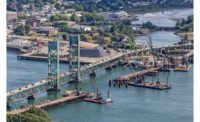A new bridge connecting Portsmouth, N.H., and Kittery, Maine, features what engineers believe is the first-ever use of precast-concrete segmental towers on a vertical-lift bridge.
The $158.5-million Sarah Mildred Long Bridge project, slated to open by year’s end, is a joint venture between the Maine and New Hampshire departments of transportation, with MaineDOT serving as the owner. It replaces a 77-year-old bi-level bridge that closed last August.
Construction on the bridge, which will carry 14,000 daily drivers on the U.S. Route 1 Bypass over the Piscataqua River, began in 2015. While the original opening has been extended by three months, no penalties have been assessed and the June 2018 completion has not changed, according to a MaineDOT spokesman.
The structural-steel twin box-girder lift span carries one lane of traffic in each direction, with a set of railroad tracks down the middle. To accommodate two railroad crossings a year, the bridge track structure will rise two feet, the bearings that support the bridge in its roadway position will rotate 90°, and the bridge will lower about 50 ft to the railway position, says Mike Hawkins, project manager with Hardesty & Hanover, teamed with Figg Bridge Group as the designers working with Cianbro in a CM-GC contract.
Figg designed the precast superstructure for the approach bridges, Hardesty designed the precast towers, and Cianbro designed the partially submerged precast-tower footing tubs, instead of one giant tub, to support 10-ft-dia shafts. This allowed the team to use a smaller crane to pick up the smaller, 65-ft x 125-ft tubs.
For trains servicing the Portsmouth Naval Shipyard, “we have only two railroad crossings per year,” Hawkins notes. “The bridge will primarily spend time in the roadway-seated position and raise up like a normal lift bridge to allow for marine traffic to clear underneath.”
On the old bi-level bridge, the rail line was always in place, though rarely used. “This limited the size of the boats that could travel underneath the bridge without stopping the traffic [for 15 minutes] and lifting the bridge,” says Paul Skelton, chief development officer at Hardesty & Hanover. Now, with a 56-ft vertical clearance in its resting position (compared to 10 ft for the old bridge), there will be 68% fewer bridge openings, according to MaineDOT.
Prefabrication and Collaboration
Many bridge components—the concrete segmental approaches and the steel twin box-girder lift span, among them—were delivered to the site from off-site vendors. “Dealing with the massive size of everything and working with off-site fabricators to have the components manufactured and delivered required a lot of coordination,” says Kaven Philbrook, project manager for Cianbro.
For the lift-span float-in, “six steel box-girders were delivered by barge on six loads from south Portland, Maine,” Philbrook says. “Unlike other projects where bridge spans are erected off site, the 300-ft by 50-ft lift span was erected on a barge to float in place during a channel closure.”
Crews precast all 88 of the tower segments on site and erected them in post-tension, Philbrook says. “We purchased a [specialty] precast form from Italy for casting segments we loaded on barges and took out to erect the towers. That’s a first,” he adds. The tower design is meant to suggest a Maine lighthouse.
Another innovaton is Hardesty & Hanover’s design of tower piers that sustain vessel impact without a large, separate fender system. “High-density absorbing [rubber] arch fenders are directly attached to the bridge tower piers for added protection,” Hawkins says.
The foundations are designed to withstand a 12,000-kip force or vessel load. “Eight caissons are drilled into rock, so you have significant capacity with those eight shafts,” Hawkins says. “Eliminating [separate] fenders maintains the channel width for shipping but reduces the required lift-span length.” The caissons, 10 ft in dia, are rock-socketed 35 ft deep into bedrock.
This fall, Cianbro crews worked around the clock with two crane barges and winches to float in the 3.5-million-lb, 300-ft-long x 50-ft-wide lift span, timing it with an extreme tide on the mighty Piscataqua River, one of the swiftest rivers in North America.
“Knowing the currents, we couldn’t rely on cables to float in the span, and we knew we needed more of a safety plan” during the 10-day channel shutdown, which began on Oct. 17, says Philbrook. One crane barge was used as a guide to help steer the lift-span barge in one direction through the strong crosscurrent, he explains. “The other barge had two tugboats with wenches and cables attached to the towers to pull the crane barge and the lift-span barge into place.” To place the span, “you had to push it into position [between the bridge towers], maintaining it within inches,” says Hardesty & Hanover’s Hawkins.
On Oct. 18, the team floated in the span during high tide. “We were able to float it down on the temporary bearings we had set up,” Philbrook says. The first lift was completed on Oct. 26, when the team raised the bridge to its fully opened position; the following day at 6:00 a.m., the team opened the shipping channel, he says. “By having a plan and backup protocols, [the float-in] went right to the minute and was in,” he says.
Since completing the float-in, the team is focusing on commissioning to start up operating systems, final paving and bridge rail installation, Philbrook says. After the bridge opening, Cianbro will demolish the old bridge through 2018. So far, Cianbro has clocked 500,000 hours with no lost-time injuries—“Just one pinched finger,” Philbrook says.







Post a comment to this article
Report Abusive Comment